Inside a tiny, wireless Bluetooth fitness tracker
For some reason my local dollar store had a ton of different types of fitness tracker devices today, all for $1.99. I decided to buy one to see what's inside. One in particular stood out for having Bluetooth, as opposed to a wired headphone jack connection. Super cheap RF devices are always fun to look at, so let's take a look.
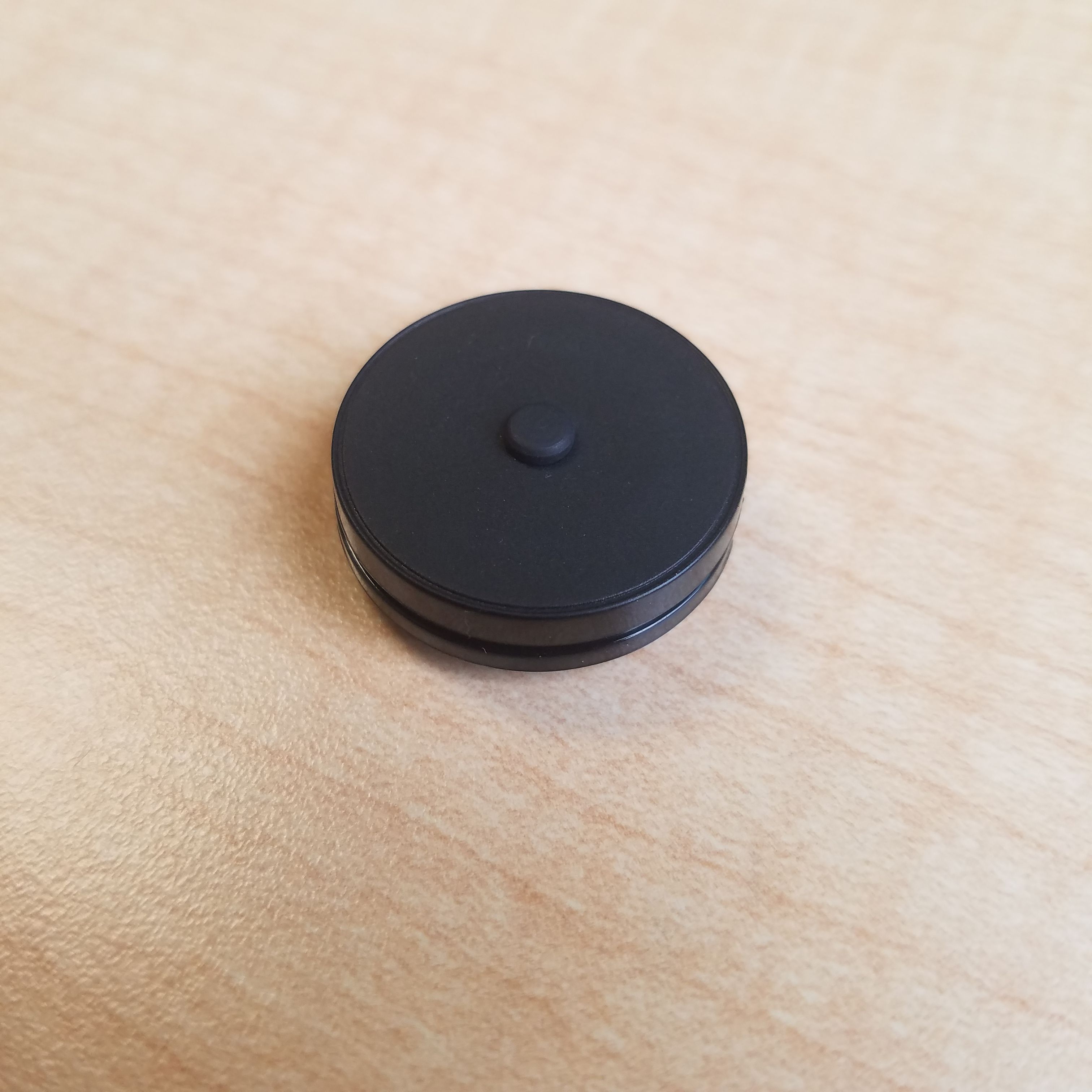
This device comes with a belt clip and a rubber wrist strap. You can pop it into either to use how you like. I never actually used it myself (not only do I have no need for a fitness tracker, but the website they told you to go to doesn't seem to exist), but it will supposedly track your steps and store up to 7 days of data. It then communicates with your phone wirelessly using Bluetooth (which uses 2.4 GHz microwaves) to send fitness data.
The little rubber button lets you turn the device on and pair it with your phone. Doing so lights up a blinking yellow LED underneath the black plastic shield.
The device is tiny - slightly larger than an American nickel. Let's see what's inside ...
Teardown & Explanation
The device is a single sealed plastic disc. I have able to peal off the back plate (containing FCC licensing stuff) to reveal the power source: A small lithium coin cell battery, running at 3 Volts. This battery can be easily removed and replaced, which is nice to see.
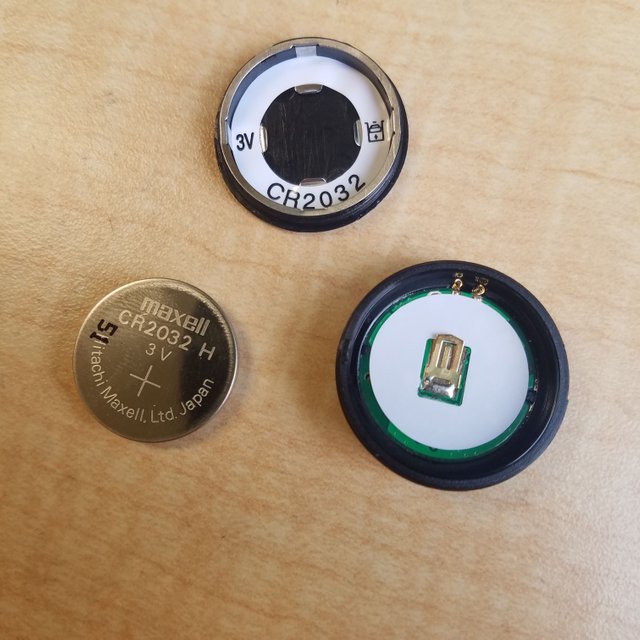
Unfortunately it isn't easy to get inside from here. The actual device itself is sealed within a curved disc of plastic and held down with glue. There are no screws or seams to make it easy to remove the circuit without damaging the device.
Since it was $2, and I wasn't even able to access the website to use it, I decided to go the destructive route. Five minutes of somewhat painfully prying away chunks of broken plastic later and I was finally able to wedge a screw driver under the circuit board and pry out the device itself. Here we see it in all its glory:
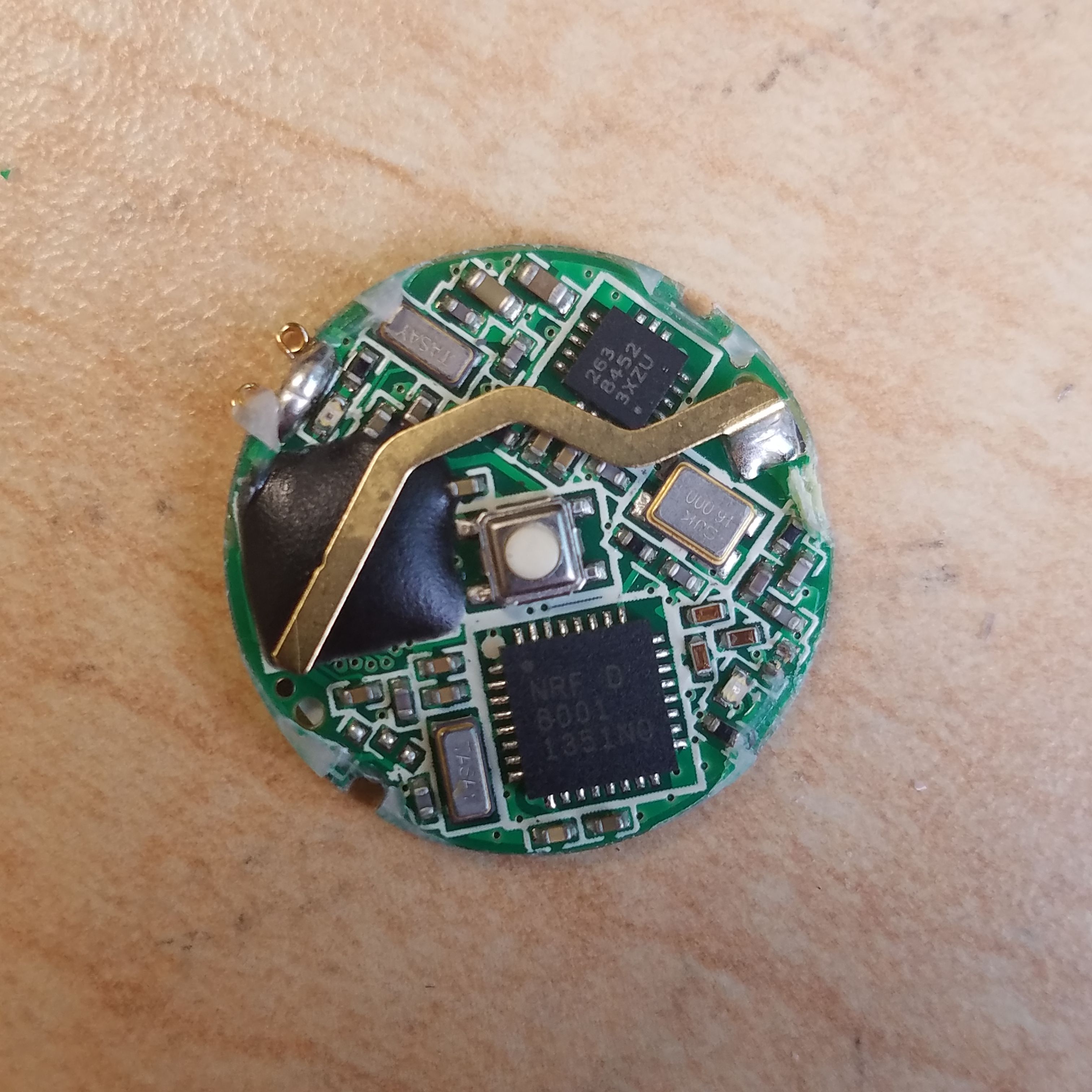
I don't know about you, but I think it looks pretty cool. They certainly didn't waste any space on this board. The metal strip crossing the board appears to be an antenna, which will transmit out the 2.4 GHz microwave pulses that Bluetooth devices use to communicate. That black glob of epoxy on the left is probably just there to hold down the antenna, since most of the circuitry is visible. The white button in the center of the device lets you turn on the tracker.
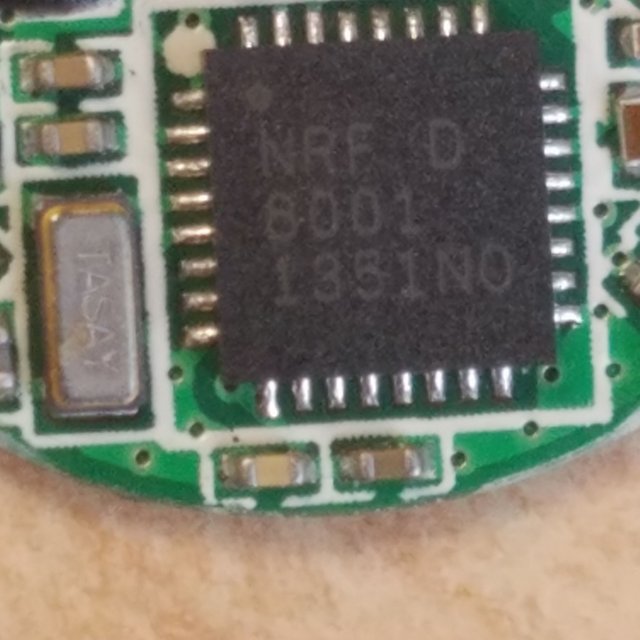
Here we can see the most important part of the device: The NRF D 8001 Bluetooth module. This complicated integrated circuit controls the actual Bluetooth signal generation, and contains an integrated temperature sensor and voltage regulation. This chip will output the microwave signal to the antenna, to be sent to another computer over the air. Upon skimming the (very long and very dense) datasheet, I found that this a BLE chip (Bluetooth Low Energy). The BLE protocol, as the name suggests, allows for small amounts of data to be sent using microwave signals, and uses much less energy than regular Bluetooth devices.
I'm not yet skilled enough to actually explain how one would build something from scratch using this chip, but hopefully I'll get here some day. I've linked the datasheet at the end of the post in case you are interested.
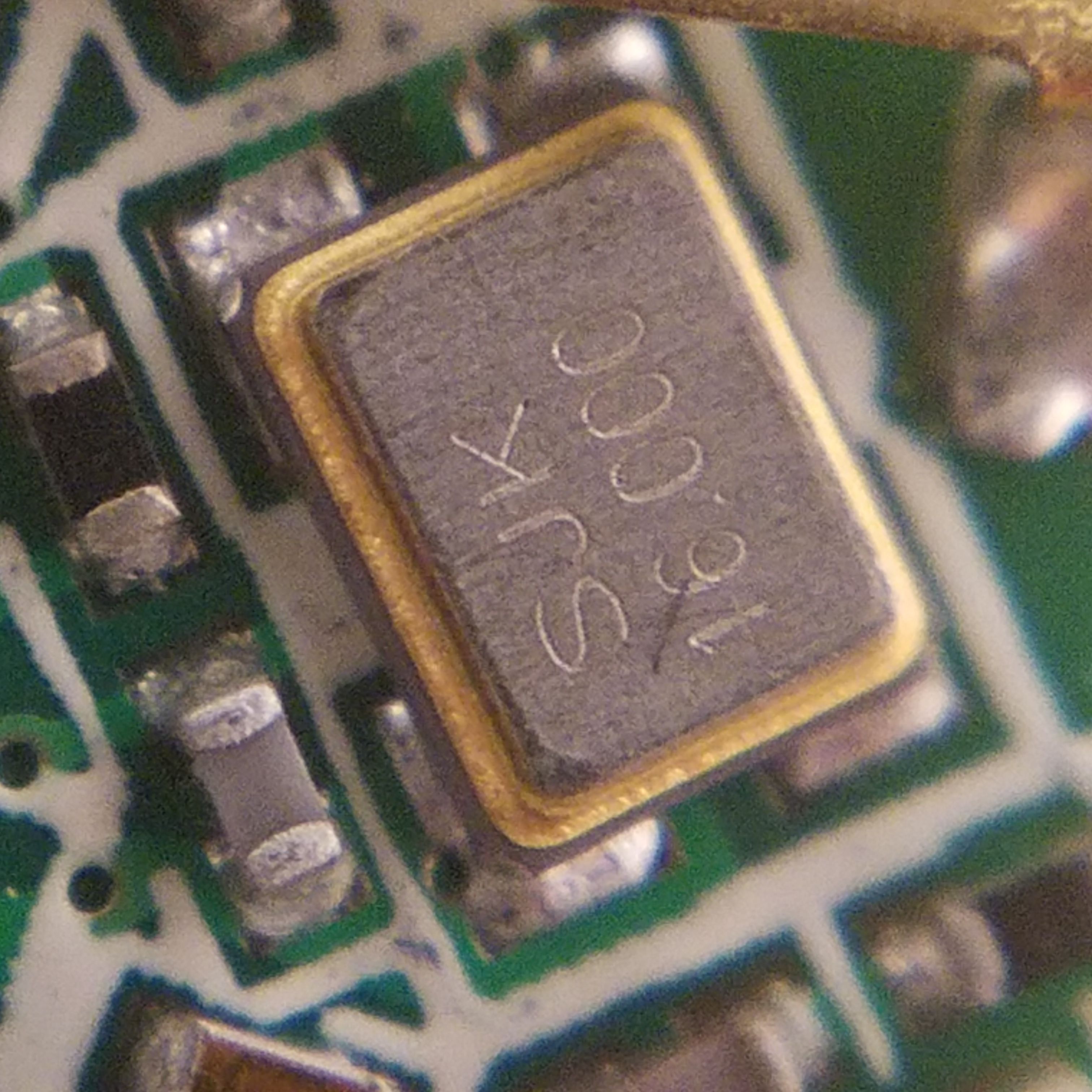
Next up is a shockingly clear (seriously, this surprised me) image of a 16 MHz crystal resonator device. I just wrote about these devices yesterday if you're interested.
The NRF BLE chip uses this resonator to operate properly. I believe the chip actually has its own internal oscillator, but in this case the manufacturer opted to use an external one.
Speaking of resonators...
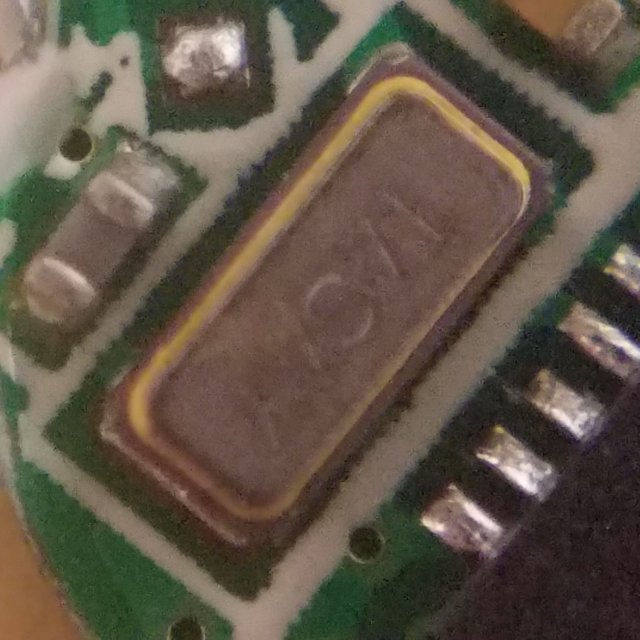
Here is a much more blurry image of another resonator on the board. At least, I think it's a resonator, as its not clearly labelled. There are two of these on the device, which based on the NRF datasheet are probably external 32 kHz crystal resonators, again used by the NRF chip. They probably provide accurate timing for the chip.
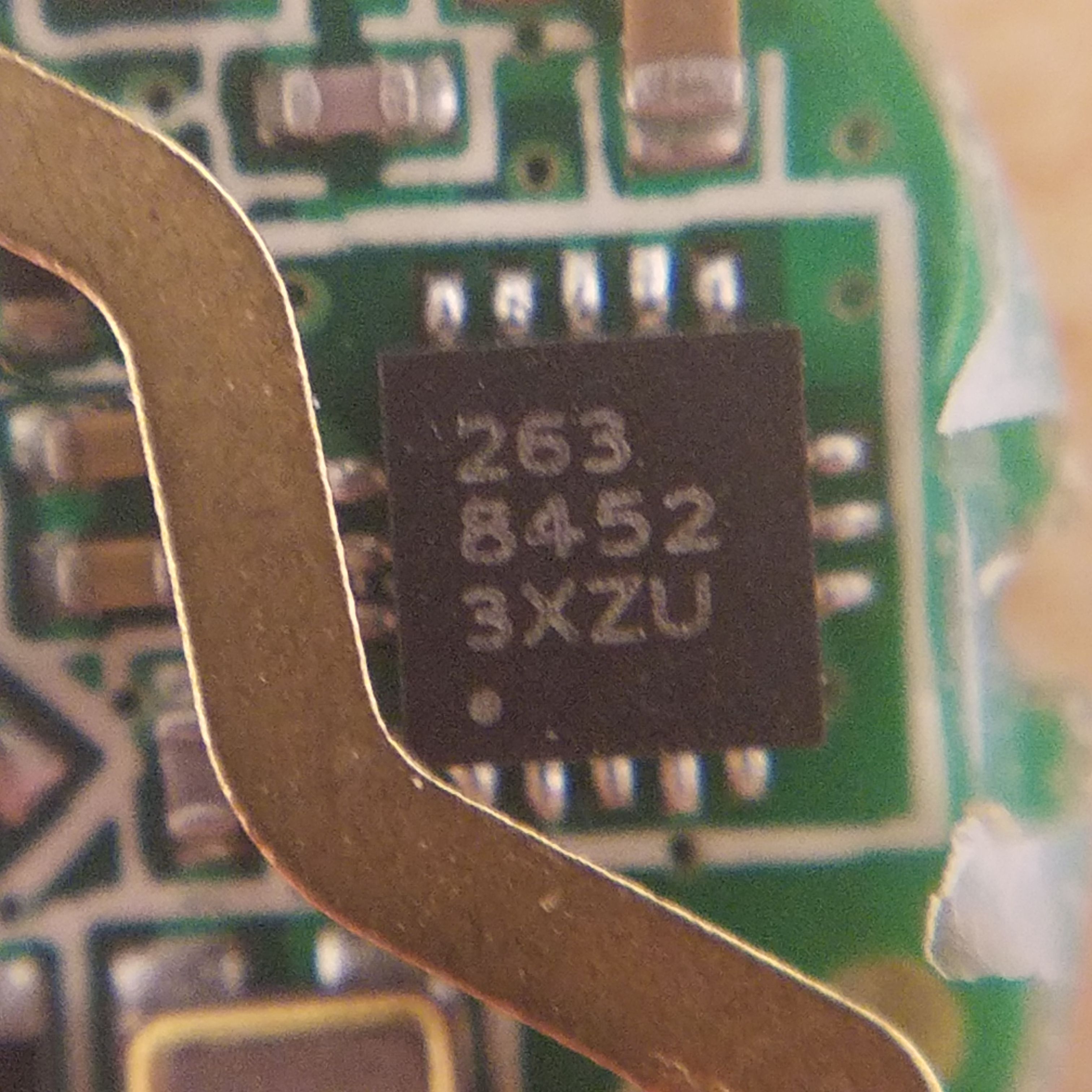
The final component of note is this smaller integrated circuit, just above the microwave antenna. The printing on the case isn't giving me any useful information, but I am extremely confident that this device is an accelerometer based on its form factor and the fact that one has to be in this device. Accelerometers measure acceleration, and as such one can be used to measure when you take a step. Any fitness tracker is then going to need some sort of accelerometer to function.
Data from this accelerometer is sent to the NRF chip where it is transmitted away as a Bluetooth signal with the data modulated into the 2.4 GHz carrier microwave.
The remaining parts are mostly capacitors and resistors. There are two LEDs (one blue, one yellow) that turn on when the device is powered on and the button is pressed. There are also three orange looking surface mount components, but I'm not sure what they do and can't get a clear look at them using my camera. You can see them to the right of the NRF chip on the overall image - let me know if you know what they are!
That's it for this teardown. I hope you found it interesting. Let me know if you have questions, comments, or corrections.
Thanks for reading!
All images in this post are my own. You are welcome to use them with credit.
It's fun to dive in from time to time into these things. It allows to step back and realize how our tech evolves.
2$ for that? even 10$ for that is quite amazing. Too amazing in fact
Actually, to be honest I thing tech is too cheap... I'd rather invest 50$ in this thing if I needed it, but
1/ (most important) know for sure that the low cost is not the result of the exploitation of 3rd world country kid...
2/ have a software that works and even customer support to help me get started if I ran into trouble making it work.
It's definitely suspiciously cheap, but I think I have the reason.
The dollar store I visit only sells >$1 electronics when they get them surplus from other stores that couldn't sell them. That's why I still sometimes find weird devices there using outdated (30 pin, miniUSB) plugs.
In this case, the Bluetooth IC (NRF 8001) itself costs over $2, and that's just one single part needed to make this work. Because of that, I think that the original product was probably around $10 but didn't sell, and as such ended up at the local dollar store for $2. They couldn't have possibly originally sold this for $2 because one single part already costs ~$2.20 or so.
Unfortunately if there was software it no longer exists, as the website this thing linked to isn't up. That also kind of makes sense, it was probably sitting in the back of some Kmart or something for years before getting sold at 1/4 off to the dollar store for resale, so the original company supporting these devices could have gone out of business. Or, I am clueless and just can't find the software haha. With only one button and no labels it would be difficult to even get it to pair without instructions.
Wow, and they sell this for $2 ? I can remember a time, when this CR 2032 battery cost $2 alone.
A pretty great price indeed... well, if I could find the software that is haha.
Keep in mind that these are dollar store electronics we're talking about - they often get them surplus because they didn't sell somewhere else. Because of that I highly doubt that this device originally cost $2, since it doesn't seem like they could turn a profit selling it for that little.
Well, true, without the matching app there isn't much you can do with it. That said, even with the app the usefulness is limited. I have a smart watch that has such functions - counting the steps ect. - the question is only: why would I want to know that? :)
I am impressed - that circuit is really compact. The one that has designed it must have known what they did.
This looks a lot better engineered than some of the other devices you reviewed. Even thought the website was not available, I wonder if it actually functions (were you able to see it the list of blue-tooth devices on your computer?).
It is definitely way too well built to have been originally sold for $2 (the NRF 8001 costs more than $2 on its own...), which is in line with the dollar store buying surplus products and discounting them.
I'll admit that I didn't actually try to pair the device before opening it due to the lack of instructions and because I really really wanted to see how they were doing Bluetooth for $2. Reconnecting the battery now, I'm still unable to get it to pair, but that is probably because I don't know what button press combination I need. There were no instructions on the box and the website seems to be down.
Have you tried to get to an archived version of the website through the wayback machine?
Sometimes I just want you to keep breaking open smaller and smaller pieces all the way to the atomic level, heh. Good stuff as always. Was looking at all the codes and digits on my laptop motherboard the other day somewhat curious and very lost
Glad you enjoyed it!
I'm getting better, but I still have a hard time understanding how all of these parts work together... or more accurately, how I would go about doing it myself if I had a pile of ICs and components. Hopefully one day I get there, I find that I learn a little bit every time I take something apart, or read a datasheet, or build my own circuit.
Hi!
You have great cycle "what inside"!
In my childhood I found it amusing to disassemble different things, apparently, therefore, and became an engineer ;-)
i hope this gadgets will work good
Yes, i found it interesting.
One question, when will you tear down a ship?
Being A SteemStem Member
Thank you for the support @steemstem!